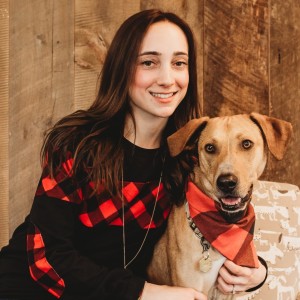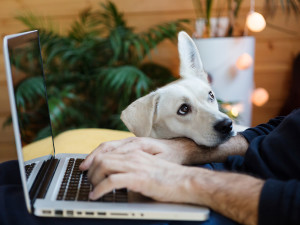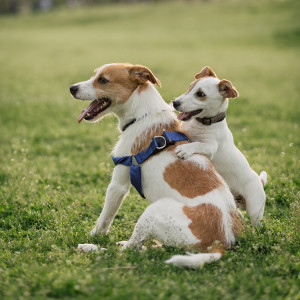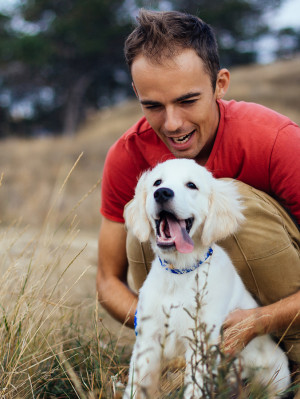Why Does My Dog Hump Me?
It’s not the best thing they do by any means.

Share Article
In This Article:
Reasons Why Dogs Humpopens in a new tab Normal vs. Excessive Humping in Dogsopens in a new tab How to Stop Your Dog From Humpingopens in a new tab Frequently Asked Questionsopens in a new tab
There’s nothing like coming home from a long day to embrace your pup in a hug and cuddle sesh, only to have your dog clamp onto your leg and hump you instead. It feels awkward and may have you questioning how your dog really sees you.
But fear not: This behavior usually doesn’t signify to dogs what it does to us, and there can be many rational explanations for why this is happening. Understanding the underlying causes of this behavior is the first step. Once you have an idea as to why your dog is humping you, you can work on strategies to eliminate this behavior. Read on to learn all about why your dog may be humping you.

littleKin™ is Kinship’s home just for puppy and kitten parents. Bop over to check out expert advice, new pet tools, and special deals—all curated for your newest family member.
opens in a new tabWhy do dogs hump people?
Dogs may hump people, other dogs, or even inanimate objects for a number of reasons, including behavioral and health reasons. In moderation, this type of mounting behavior is normal and is part of how dogs interact opens in a new tabwith one another. However, there may be situations where the behavior becomes excessive, or simply unwanted, and it is important to determine the root cause of their mounting behavior in order to stop it.
Are you supposed to let your dog hump you?
No; there is no good reason to let your dog hump you. If your dog only does this rarely, and it doesn’t bother you, there is no need to panic, and you can choose to ignore it. However, if your dog is doing this frequently, especially to other people who may not be as understanding, and/or if it really bothers you, it’s important to stop the behavior. This is not only for your benefit, but also for your dog’s benefit. Excessive mounting behavior is a sign of a problem, either behavioral or medical, and your dog needs help.
Reasons why your dog may hump you
Dogs may exhibit mounting behavior due to behavioral or medical reasons. Sometimes there is overlap between medical and behavioral reasons, too. The most common causes include:
Behavioral reasons why dogs hump
Displacement behavior: Basically, this is the idea that a dog exhibits a behavior as an outlet for other emotional energy. For example, if your dog is very excited, frustrated, or anxious about a situationopens in a new tab, they may displace that energy through an activity like humping.
Attention-seeking: Mounting can also be a way of seeking attention. The behavior itself often gets everyone’s full attention, and even if this is negative attention, it can unintentionally reinforce the behavior. If the dog starts to associate humping with getting your full attention, this may encourage them to do so.
Play: Dogs will sometimes display mounting behavior during play with other dogs, and this is often a normal interaction. Your dog may attempt to hump you during play sessionsopens in a new tab for the same reason.
Health-related reasons why dogs hump
Sexual arousal: The most basic explanation for why a dog humps is sexual arousal. For dogs who are intact, this is especially true, because they have a hormonal drive to reproduce and become naturally sexually aroused. Dogs who are spayed and neuteredopens in a new tab can also experience sexual arousal, although this drive tends to be diminished.
Pain: Humping behavior can sometimes be secondary to painopens in a new tab, most commonly in their urinary or reproductive tracts. This can include conditions like urinary tract infections, injuries, congenital malformations of their anatomy, and more.
Itchiness: Similarly, dogs who are very itchyopens in a new tab, especially around their genitals or anus may hump due to discomfort.
Hormonal influences: Sometimes there can be another source of hormones that are causing sexual arousal in dogs. This can happen with certain tumorsopens in a new tab that secrete hormones, as well as exposure to human medications, including topical creams, that contain hormones.
Why does my dog try to hump a specific person?
Hints as to why a dog humps a specific person will be found in the context of who, when, and where this occurs. For example, is this a person your dog is very attached to, or someone they are unsure of? Does this tend to happen during moments of excitement and play, or during times when your dog seems fearful? Is this happening on your home turf or when you go out to a specific place?
Analyzing the context will help explain your pup’s behavior. They may be humping their favorite person out of excitement or when they are seeking attention after being separated for long periods of time. Or, they may be humping someone they see as a stranger when they don’t know how to interact with them. There may be many other permutations to explain their behavior, too, so look for context clues.
Normal vs. excessive dog humping: when is it time to get help?
It’s never wrong to get help, so if you’re feeling overwhelmed and not sure how to best help your pup, ask for help. You can start by speaking with your vet and/or a behaviorist opens in a new tabwho can help you home in on what’s going on and why. It’s also very important to seek veterinary care if you’re concerned that there is a medical reason for your dog’s humping, especially if you’re seeing other physical changes that have you worried. Also, if your dog’s humping has become so intense that it is interfering with other activities, if they are injuring themselves or others while humping, or if you have tried the strategies to stop their behavior and you’re not making progress, ask for help. How to stop your dog from humping you
As you may have surmised by now, there is no one-size-fits-all quick fix for every over-eager humper. The best way to stop your dog from humping you is to figure out why they are doing it. In cases with a behavioral cause, a combination of behavioral modification strategies, training cues, and lots of physical and mental enrichmentopens in a new tab will be your best tools.
This may include techniques to deter the behavior, including turning away from your dog, redirecting them to a more constructive activity, and/or using cues likeopens in a new tab “leave it,” and mat trainingopens in a new tab to give them instructions for what you want them to do instead. It is important not to scold your dog opens in a new tabharshly or punish them for this behavior as this may exacerbate other symptoms related to anxiety and fear, as well as giving more attention to the behavior.
For all dogs, but especially dogs showing signs of behavioral distress — ensuring they are getting lots of physical exerciseopens in a new tab everyday, and providing added mental enrichment through food puzzles, training sessions and socialization — are also very important for their mental health. And of course, always seek help from a certified behaviorist and/or your veterinarian if you need guidance in crafting the best approach for your pup.
Final thoughts: Why does my dog hump me?
There are many reasons why your dog may hump you, and you can use the context of these incidents to help you figure out their motivation. Be sure to consider both medical and behavioral causes and see your vet if you are concerned that there may be an underlying medical problem.
Bottom line
Dogs hump people for many different reasons, including underlying behavioral and medical reasons
It is important to analyze your dog’s behavior in context to determine the likely triggers and causes for their behavior
There are many ways to deter your dog from humping and you can work with your pup to modify this behavior
Don’t be afraid to seek help from your vet or a certified behaviorist if you’re overwhelmed or feel like your pup has a more complicated problem
FAQs
Why does my female dog hump me?
Female dogs hump people for the same reasons as male dogs. There can be many behavioral and/or medical reasons why this is happening so it is important to analyze their behavior in the context of what else is going on in those moments.
Why do dogs hump?
Humping, or mounting, is a normal behavior in the dog world and can have many meanings. As dogs have been domesticated, this behavior is sometimes applied to other species like humans or other pets in the home, as well as inanimate objects.
Do dogs hump because they like you?
Sometimes yes, sometimes no. A dog might hump someone because they are excited to see them or they are seeking attention, but many other possibilities exist as well. Humping can be a sign of many different emotions so it is important to evaluate their behavior situationally.
Do dogs hump their favorite person?
Some dogs will hump their favorite person because they are excited and/or seeking attention. They may also hump a person because they feel afraid or are unsure how to interact with them, so it is not a guaranteed sign of affection.
References
Bergman, Laurie. “Canine Mounting: An Overviewopens in a new tab.” Clinician’s Brief, January 2012, pp. 61-63.
Didehban, Negar, et al. “Problematic Behaviors in Companion Dogs: A Survey of Their Prevalence and Associated Factors.opens in a new tab” Journal of Veterinary Behavior, vol. 39, September-October 2020, pp. 6-13.
Norris, Breanna. “Why Does My Dog Humpopens in a new tab?” Cattle Dog Publishing, 26 June 2023.

Danielle Vrabel, CPDT-KA
Danielle Vrabel is a dog trainer who earned her CPDT-KA in 2020. Danielle is a proud pet mom of five pets: two dogs, two cats, and a corn snake. Danielle has fostered over 10 dogs and 15 cats/kittens as well as helped train shelter dogs before they are adopted. Both of Danielle’s dogs are pet therapy dogs, where she also volunteers her time helping evaluate future therapy dogs.

Dr. Amy Fox, DVM
Amy Fox, DVM is a small animal veterinarian in New York City. A lifelong animal lover, Dr. Fox studied biology in college and then worked as a veterinary nurse before pursuing veterinary school at Cornell University. She has worked in many different settings including shelter medicine, emergency medicine, general practice, and animal cruelty and forensics. She is especially interested in nutrition, preventative medicine and care for senior pets. Dr. Fox also enjoys writing about veterinary medicine and teaching. In her free time she loves to cook, garden, and go for long runs.
Related articles
![Dog Seeking Attention Owner Working On Laptop.]() opens in a new tab
opens in a new tabWhy Is My Dog Being Clingy?
Your dog’s Velcro habits are cute—but not always convenient.
![Small dog humps its teddy bear toy on the room floor]() opens in a new tab
opens in a new tabHumping. Why, Though?!
No less than 7 animal behaviorists weigh in on what’s behind all of this bumping and grinding.
- opens in a new tab
Does Your Dog Think Every Day Is Hump Day? Dog Humping and How to Stop It.
In moderation, it’s normal. Excessively? It’s not.
![weird dog rolling in poop]() opens in a new tab
opens in a new tab7 Weird Dog Behaviors Explained
Chasing their tails, eating grass, and rolling in garbage — should you worry?
![Young Man With Retriever Puppy]() opens in a new tab
opens in a new tabWhen Should You Spay or Neuter Your Dog?
The research is confusing—here are some guidelines.




